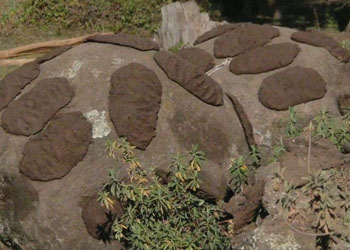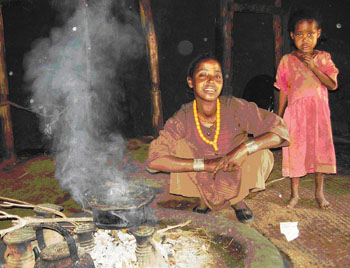Indoor air pollution
Cooking activities inside the main tukul, where family members spend most of their time, generates smoke that is hazardous to health. Mothers, children and elders are the ones who are most exposed to the effects of smoke. The usual type of fuel that is used for cooking and heating in the rural areas is biomass, i.e. animal dung (kubet) (Figure 4.4), crop residues and wood. Biomass fuel is understood to be inferior to, say, kerosene, because it is not energy-rich when burned. An inadequate supply of oxygen to the fire and wetness of the fuel increases indoor smoke. Biomass fuel generates visible smoke which is composed of a number of chemicals that are hazardous when breathed in. Carbon monoxide and tiny carbon particles (tilashet) are dangerous if inhaled.

Indoor air pollution occurs when the air inside a tukul is predominantly smoke instead of clean air (Figure 4.5). The presence of indoor air pollution is associated with acute respiratory infections, bronchitis and chronic lung diseases among children and mothers. You can help to prevent indoor air pollution by:

- Advising the family to use an efficient stove that minimises fuel consumption and therefore smoke emission. The improved stove must be equipped with a chimney.
- Promoting the separation of the kitchen from the main house.
- Promoting the separation of animal sheds from the main house because fresh animal dung and urine produce bad odours when decaying.
- Advising mothers to cook without involving children in the kitchen.
- Recommending that a window be installed and left open until cooking is finished.